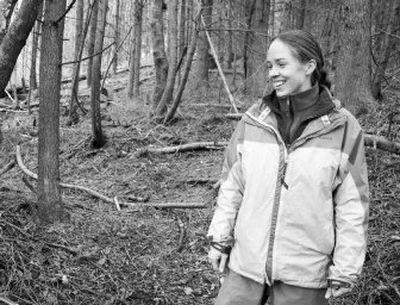Deal smells sweet, and skunky

ASTORIA, Ore. – With mud from the Crosel Creek flood plain sucking at her boots, North Coast Land Conservancy land steward Katie Voelke hikes through a valley between two tree-covered hills south of Astoria.
She takes a deep breath and sighs.
“There’s nothing like the smell of skunk cabbage in spring,” she says. “It gets more and more pungent as they bloom. These are the smells you learn to love when you work in wetlands.”
Spring is smelling sweet – and a little skunky – for the North Coast Land Conservancy, a Seaside-based nonprofit organization that manages hundreds of acres of habitat in the region with help from local communities. The group recently acquired 121 acres of forested wetlands surrounding Crosel Creek in Astoria, bringing its title holdings to about 1,500 acres in Tillamook, Lincoln and Clatsop counties.
A smattering of the sprightly green skunk cabbages, many with hood-like yellow blooms, sprouts out of the swampy Crosel Creek valley on the conservancy’s new property. Voelke says the prevalence of skunk cabbage and slough sedge or “sawgrass” bunches are signs of a healthy wetland ecosystem.
As she progresses through the waterlogged turf, other indications of intact wetlands abound: new spruce saplings rooted in the decaying wood of fallen trees, giant root wads jutting out from the waterline and providing habitat for upland wildlife, the soggy depression in the valley bottom marking an old trail Crosel Creek once followed, and the sloped banks of the clear-running creek that allow for flooding during high-water events.
“Because it’s so highly connected to its flood plain, this is also Crosel Creek – these areas of seeping, muddy wet,” said Voelke. “Most of these lowlands around Youngs Bay have been diked and drained and turned into pastureland. But probably at some point they were spruce-dominated wetlands – even back to Lewis and Clark. You see in their journals they talk about extensive swamps, and we don’t have extensive swamps, so it must have changed since then.”
The creek is used by coastal cutthroat trout and juvenile salmonids, who access the creek via Youngs Bay and use it for rearing habitat. The surrounding property provides refuge for a wide range of wildlife, including great blue heron, pileated woodpecker, band-tailed pigeon, Roosevelt elk and black-tailed deer.
Making his way up the valley, Neal Maine, executive director for the conservancy, calls out to Voelke: “You hear that? That’s a gray-horned owl! You can hear its call.”
It took about two years for the conservancy to complete the Crosel Creek land acquisition, which was recently finalized. Maine and Voelke spent weeks evaluating the property before sending their first grant application to the Oregon Watershed Enhancement Board. The habitat ranges from upland forest dominated by Western hemlock and Sitka spruce to lowland riparian woodland and shrubland. There is intertidal freshwater wetland, and a portion of the property is hardwood forest containing a rare community of bigleaf maple and red alder trees, with native sword fern and fringecup plants.
The conservancy bought the land for $575,000 with help from the Oregon Watershed Enhancement Board, the Columbia Land Trust and the Pacific Power Conservation Fund. The landowner, Helen Gaston of Seaside, contributed $30,000 to the conservancy’s endowment fund to cover the costs of managing the property.
“I think what is happening now with the North Coast Land Conservancy is perfect,” said Gaston. “I wasn’t even aware of how important that part of the watershed was until they brought me pictures. I think they’ll take care of it.”
The Gaston family purchased the land during World War II for cow pasture and later logged some of the forest. Gaston said her late husband, Robert, was a logger like his father and grandfather but did not heavily harvest the land around Crosel Creek.
The low frequency of logging on the property has helped preserve the integrity of the creek, said Voelke, standing beside the swift-flowing channel.
“If the forest above had been disturbed you would have muddy, highly turbid water after rain,” she said. “But clearly it can recover from rain.”
Maine said rather than preserving the individual plants and trees on the land, the goal is to preserve ecological cycles and the natural connectivity among the ecosystems.
“Preserving it as if it’s static – that’s what development does,” he said. “We make sure it’s not locked up into one specific use. We’re basically unlocking it and allowing the dynamic ecological cycles to take over.”
Voelke said acquisition is an important first step in a collaborative process involving the conservancy and the local community. Eventually, the organization may open the property up to bird watchers and nature lovers.
“Purchasing is just the beginning of the project,” she said. “It’s the beginning of the rest of time.”